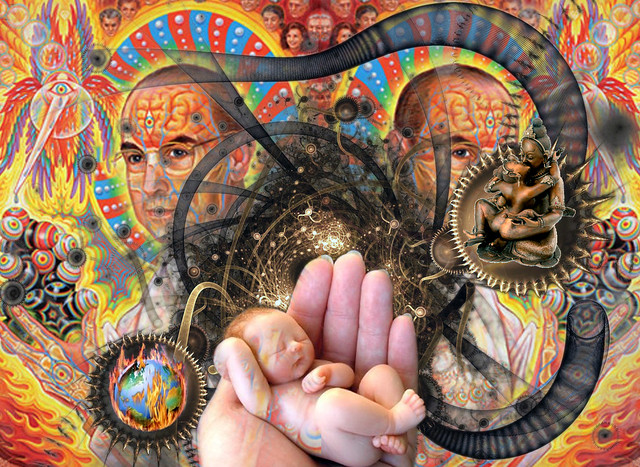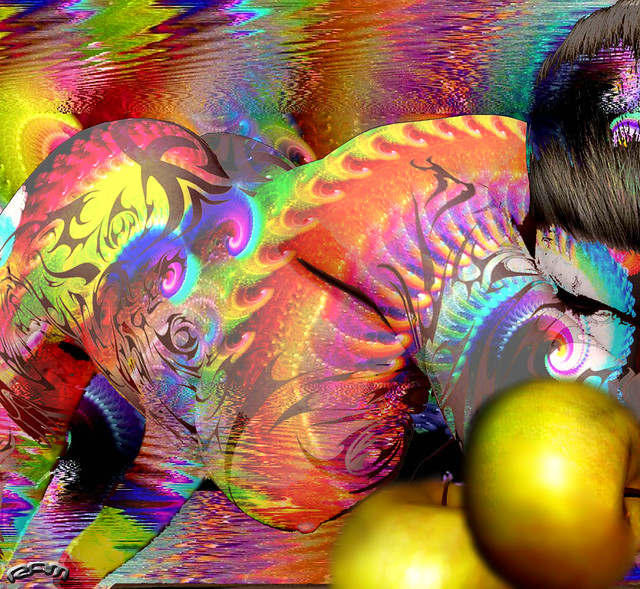Mushroom Gnosis
Simon Powell's Psilocybin Solution

In my zone of research, psychedelics and language, Simon Powell is a card-carrying member of the Guild of Xenolinguists. Xenolinguistics is the study of alien languages. I use the term to designate a class of psychedelic experience which involves visions of novel symbolic systems, novel ideas about language, and communication with the high strangeness of the Other. Powell’s work, "The Psilocybin Solution, The Role of Sacred Mushrooms in the Quest for Meaning," (Park Street Press, 2011) concerns the ability of the psilocybin experience to deliver high-speed downloads; information transmission as communication with the Other; and especially, information delivered as a visual language of intense concentration. The Psilocybin Solution, stands in counterpoint to the 20th century’s “final” solutions, the counterbalancing light to that deepest darkness of the human spirit, the title capturing the seriousness of Powell’s message.
You can’t put this book safely in a genre: there’s a brief social history of psilocybin: Maria Sabina, Wasson, Leary, Koestler, Huxley. There’s neuroscience, a ride through the neuronal network, the vast electrochemical signaling system that produces the spectrum of conscious experience across multiple states. Powell covers in general terms the actions of psychedelics as neurotransmitters, binding to the same receptors as serotonin and other neurotransmitters with major changes in one’s state of consciousness as a result.
But to me, this reads as a wonder tale, a once-upon-a-time narrative, deeply personal, effervescent tale of the adventures of an enthusiast in a psilocybinetic state of mind. The narrative voice avoids the inflation one sometimes hears in ‘the tale that must be told;’ the story is delivered with a pocketful of wry at every turn. The book takes off with the introduction of his concept of information:
“Whether it be a vivid dream or an entheogenic vision, the normal perception of an object or a psychedelic perception, the underlying structure of such experiences can now be discerned. The common mediating factor is information, and the way that information is transmitted, organized, and substantiated by the neuronal firing activity of the brain. Information, the “currency” of the brain, emerges as the key concept in explaining the normal conscious mind, the entheogenic mind, and the dreaming mind.”
The discourse on intelligent design goes back at least as far as St. Thomas Aquinas. Intelligent design became identified with the fundamentalist assertion of creationism, a doctrine that opposes Darwinian evolution, and virtually every scientific argument for natural evolutionary processes. Psychedelic studies has its own take on intelligent design, approached from the knowledge gained in altered states of consciousness, in which Nature itself, and all its densely intertwingled components, are perceived as radiantly intelligent. Intelligence is redefined as a quality, not only of humans but of all life forms.
Jeremy Narby’s book, Intelligence in Nature, speaks to this point. Ayahuasca research, and the broader exploration of South American plant medicines, all speak of direct communication with the spirits of plants, of plants as intelligent teachers. This brand of natural intelligence is a central concept for Powell as well. And Nature, for Powell, goes beyond our biosphere and ultimately includes both animate and inanimate Nature: ‘life, the universe, and everything.’
“…mind stuff resolves itself as being informational stuff. This is perhaps not too controversial a claim, but what I eventually hope to show is that matter, or physical stuff, is also informational in nature. This would mean that everything, whether atoms, molecules, organisms, or thoughts, could be described in informational terms.”
Powell introduces his discussion of the Other—the experience of the felt presence of an Other in psychedelic, especially psilocybin states—in terms of information and its transformations. Terence McKenna comes back time and again to the consideration of these Otherly experiences, especially with the mushroom, and entertained many hypotheses about its nature, from being the voice of the mushroom itself, speaking as an alien import, to the voice of the Logos itself, imparting knowledge through the agency of the be-mushroomed state.
Surely the question of the nature of the Other, (who are those guys anyway?) and the source of the knowledge they deliver (is this from a previously hidden part of “my own” psyche, or from a source outside of “my self”?) is one of the enduring mysteries of the psychedelic experience. Reports of the alien Other confounded Rick Strassman in his DMT research. Cultural frameworks such as shamanism on the one hand and science on the other deliver widely different interpretations. In psychedelic studies, epistemology—what do we know, and how do we know what we know—is an extreme sport. Powell concludes,
“The Other thus represents a name, or label, for the kind of information processing underlying the visionary state. An apparent communion with the Other demonstrates the inherent property of neuronal information to purposefully organize itself into streams of ideas laden with profound meaning. If one can conceive of the mind as being a kind of informational process, one can equally envisage the Other as being an informational process. Whatever the actual neuronal firing mechanisms involved, it seems likely that the self-organization, or forced coherence of immense amounts of information underlies the felt presence of the Other.”
Psychedelic experience makes more information available to the conscious mind. Anthropologist Michael Winkelman describes this in terms of psychointegration—the cortex receiving information from parts of the brain normally filtered from conscious awareness. Powell describes a state of informational flooding with psilocybin, resulting in the coalescence of new information patterns in the form of the constellation of the Other, and of “highly similar mythical images and symbols full of meaning and associative power.”
These highly condensed units of information organize themselves in linguistic structures. Powell’s description of language:
“…language is essentially an informational system not restricted to words alone. Language, in the abstract way in which I refer to it, is a system of informational elements bearing definite relations with one another; hence a language of words, of molecules, of symbols, and so forth.”
And the connection of information, organized into new forms of language, with the Other, is tightly drawn, and its qualities outlined:
“To partake of a visionary dialogue is to be overwhelmed by the direct apprehension of pure, unadulterated meaning, which arises as a consequence of the highly integrative informational processes liberated by entheogenic compounds. . .Here we begin to understand what the shamanic visionary experience is like, that it consists essentially of a communication transmitted in the higher language expressed by the Other, a language of symbols embodied in animated imagery.”
Language, for Powell, goes all the way “down,” into the fundamental organization of matter, and all the way “up” as the highly condensed visionary symbols of a “higher” language of the human psyche—numinous, condensed expressions of meaning. Powell describes a living language: animated, personal, responsive.
“Universally powerful visionary symbols can be thought of as expressions in the dictionary of a “higher” language connected with the human psyche. What I mean by “higher” is that the visual elements in this language are far more rich in meaning and informational content than the words of our spoken language. . .”
Powell sees the content of the visionary sequences originating in the personal memories of the individual experiencer. I agree with his description of the patchworking phenomena by which pieces of experience are recombined into powerful new communications. However, many reports by psilocybin and DMT users especially describe additional content so profoundly novel (alien is the word often used) that they can in no way be subjectively connected to personal memories.
My own analysis of the reports of xenolinguists such as Allyson Grey, Jason Tucker, and Terence McKenna, validates Powell’s observations of the construction of visionary dialogues with the Other. The literature of shamanism also reveals, in different cultural contexts, the dialogue with the Other as the source of knowledge: diagnosis, healing, divination, and the production of symbolic art forms (as in Tukano and Shipibo artifacts).
As Powell summarizes:
“…whether personal or universal, information becomes incorporated into entheogenic visions in a novel and creative way such that a definite message or meaning is conveyed, or at least appears to be conveyed. The resulting overwhelming confrontation with a spiritual intelligence is the result of information integration to the point where the integrative process appears to be alive, purposeful, and distinct from the self or ego. This is the transcendental Other, a sentient informative entity that is not us but something very closely related to us.”
A theoretical view—that the Universe is computational, its “stuff” is language-like—is transforming in our times into a practical reality. The stuff of the Universe becomes, in Mark Pesce’s phrase, “linguistically pliable.” The genetic code can be molded into new life forms. Nanotechnology gives us writeable molecular configurations. And at the macro level, additive manufacturing (3D printing) is progressing beyond the manufacture of shaped geometries to the shaping of multiple materials within materials that embody behaviors—sensing, reacting, computing (New Scientist, July 30—August 5th, 2011).
The book concludes with Powell’s “fantastic hypothesis,” which brings together his arguments about the mushroom’s visions, information, natural intelligence, language, and a computational universe in one package. It’s a whopper, and I won’t spoil the experience of discovering it yourself. Just a hint:
“…the reality process around us can similarly be viewed as a fourteen-billion-year-long translation of the Other from one language-like form into another…”
Psychedelic self-exploration, call it psychonautics, is research in the most basic form: ingest a substance, observe the experience, report, and interpret, as best you can. Repeat the experiment. Compare results with other experimenters. Most of this research is informal, our reporting is verbally to each other, sharing experiences, best and worst practices, tips and tricks, trying to figure it out, attempting, little by little, to integrate the floods of information into our lives at baseline, in the quest for meaning.
Simon Powell’s wonder tale ends with the requisite happy ending, and a call to action:
“This is like the plot of some elaborate adult fairy tale. If we genuinely wish to gain self-knowledge and realize our place within Nature’s endlessly creative transmutations, we can deliberately seek out and consume the “truth.” Like cosmic actors, by performing an age-old ritual act in time and space, we can perceive the world afresh and anew. Through psilocybinetic gnosis we may even glimpse the full majesty of this astounding Universe in which we are so privileged to find ourselves.”
Read this book. Follow directions in the last chapter closely. Confirm or deny.
Image by afgooey74 on Flickr courtesy of Creative Commons Licensing
From Reality Sandwich @ http://www.realitysandwich.com/mushroom_gnosis
For further enlightening information enter a word or phrase into the search box @ New Illuminati or click on any label/tag at the bottom of the page @ http://nexusilluminati.blogspot.com
And see
The Her(m)etic Hermit - http://hermetic.blog.com
New Illuminati – http://nexusilluminati.blogspot.com
New Illuminati on Facebook - http://www.facebook.com/pages/New-Illuminati/320674219559
This material is published under Creative Commons Fair Use Copyright (unless an individual item is declared otherwise by copyright holder) – reproduction for non-profit use is permitted & encouraged, if you give attribution to the work & author - and please include a (preferably active) link to the original along with this notice. Feel free to make non-commercial hard (printed) or software copies or mirror sites - you never know how long something will stay glued to the web – but remember attribution! If you like what you see, please send a tiny donation or leave a comment – and thanks for reading this far…
From the New Illuminati – http://nexusilluminati.blogspot.com


Nice summary I'm starting the book right now his movies and interviews are compelling, I just restumbled upon him during a mescaline+acid trip and he was just saying what I was thinking...
ReplyDeleteAre you looking to elevate your travel with Asiana Airlines? Need help on How to cancel and refund at Asiana Airlines Flight? For assistance, contact Asiana Airlines at OTA+1 800 970 3794 (no wait).
ReplyDeleteHow to cancel and refund at Asiana Airlines Flight?